The Sony a6400 was announced on January 15th 2019 and basically replaced the Sony a6300.
Sitting between the a6100 and a6600, the a6400 turned out to be the most popular choice for photographers looking for an APS-C camera that didn’t break the bank.
The Sony A6400 Shooters Group that I run on Facebook is testament to this. At the time of publishing this article it has over 25k members and it is still growing strong, adding hundreds of new members each week.
On July 12th, 2023 the Sony Alpha a6700 was announced and although this camera is not intended as a direct replacement for the a6400, I hope some of you might still find this detailed comparison helpful.
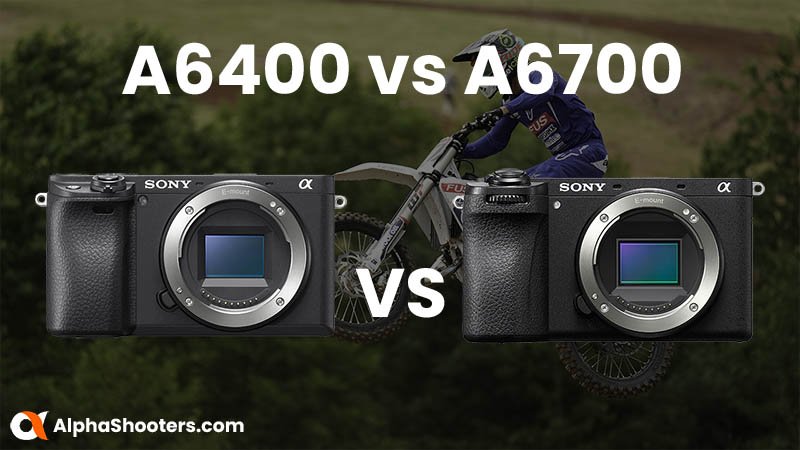
Table of Contents[Hide][Show]
- Summary
- Key Shared Features
- Key Spec Comparison
Key Differences+−
- Sensor and Processor
- ISO Sensitivity
- Still Image Recording Formats
- Video
- Stabilization
- Autofocus
- Shutter
- Drive Speed & Buffer
- Electronic Viewfinder and LCD Display
- Improved Menu and Touch Control
- Camera Body & Controls
- Full-time DMF
- Focus Bracketing
- Flicker Suppression
- Memory Cards
- Load / Save Settings (CAMSET)
- Battery Life & USB Charging
- Live Streaming / Webcam
- Firmware Updates
- Connectivity
- What’s in the Box
- Price
- Summary
- Reviews
- Sony A6700 Guides & Resources
- Sony A6400 Guides & Resources
- Complete Specification Comparison
Summary
The a6700 offers a lot for video shooters with 4K60p / 4K120p, In-body Stabilization and an excellent vari-angle LCD. Superior autofocus performance and subject tracking will also help you to track and capture more difficult subjects. On the other hand, the a6400 despite its age still provides excellent value for money.
Jumping from the a6400 to the a6600 was never a particularly big upgrade. You would really only benefit from the in-camera stabilization (if important to you) and the larger battery.
However, jumping from the a6400 to the a6700 offers some serious benefits and will most likely appeal to many a6400 shooters who are itching to upgrade.
If you have the money to spend on the a6700 then this would definitely be my recommendation. It’s a much better camera all-round than the a6400 which is now starting to show its age.
But if you have a tight budget then the a6400 still packs a serious punch and is capable of capturing some amazing images and movies.
Key Shared Features
Before we look at the differences, here’s a list of the key features that these two cameras share in common:
- Dust-and moisture-resistant magnesium-alloy body
- 14-bit RAW image files
- Single memory card slot
- 2.36 million dot EVF
- Max 11 FPS (Frames Per Second) drive speed
- 1/4000 to 30 sec mechanical shutter speed
- 5 axis in-body stabilization
- Micro HDMI port
- Microphone input (3.5mm)
- Stereo microphone and speaker
- USB charging
Key Spec Comparison
Here’s a quick look at how the key specifications stack up.
| Specification | Sony A6400 | Sony A6700 |
|---|---|---|
| Sensor: | 24.2 MP APS-C Exmor™ CMOS | 26.0 MP APS-C Back-illuminated Exmor R CMOS |
| Processor: | BIONZ X | BIONZ XR |
| Stabilization (IBIS): | No | 5-axis |
| Electronic Viewfinder (EVF): | 2,359,296 dots | 2 359 296 dots |
| Display (LCD): | 921,600 dots adjustable up and down | 1 036 800 dots vari-angle |
| ISO Sensitivity Stills: | ISO 100-32000 (expandable ISO 50 to 102400) | ISO 100 – 32000 (expandable to ISO 50 – 102400) |
| ISO Sensitivity Movies: | ISO 100-32000 | ISO 100 – 32000 |
| Movie Resolution Max: | 4K30p | 4k60p / 4k120p |
| Memory Cards: | Memory Stick PRO Duo, Memory Stick PRO-HG Duo, Memory Stick Micro (M2), SD memory card, SDHC memory card (UHS-I compliant), SDXC memory card (UHS-I compliant), microSD memory card, microSDHC memory card, microSDXC memory card | UHS-I/II SD cards |
| Shutter Speed Still Images: | 1/4000 to 30 sec, Bulb | 1/4000 to 30 sec, Bulb (1/8000 electronic). |
| Max Frames Per Second: | 11 (mechanical shutter), 8 (electronic shutter). | 11 |
| Price (MRRP): | $898.00 / £899.00 | $1,398.00 / £1,449.00 |
| Price Check: | B&H Photo | Amazon | B&H Photo | Amazon |
Key Differences
Now let’s take a much closer look at the key differences between these two APS-C cameras.
Sensor and Processor
The Sony a6400 features a 24.2 megapixel APS-C Exmor™ CMOS sensor. This utilizes thin copper wiring, enhanced circuit processing, and an enhanced front-end LSI to boost light-gathering abilities, reduce noise, and increase readout speeds.
The Sony BIONZ X image processing engine in the a6400 works together with the Exmor™ CMOS sensor to perform data processing that helps to enable lightning fast AF acquisition times. At 0.02 seconds the AF acquisition speed easily beats the 0.05 seconds of its predecessor the Sony a6300.
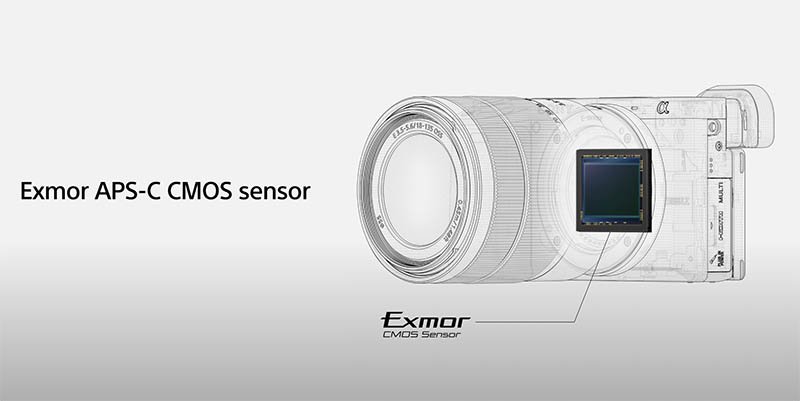
The Sony a6700 features a much newer 26.0 MP APS-C Back-illuminated Exmor R CMOS sensor. In fact, this is the same sensor than can be found in the Sony FX30.

The back-illuminated structure enhances light collection efficiency, expands circuitry scale, and with the help of a copper wiring layer that contributes to quicker data transfer, outputs data at a very high speed, while minimizing noise.
The a6700 also features a much newer BIONZ XR™ processor that delivers up to eight times more processing power than the BIONZ X found in the a6400.
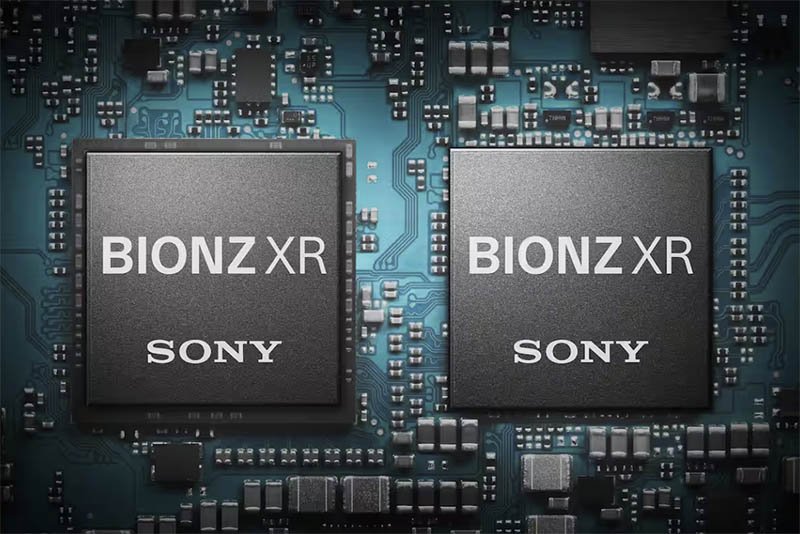
ISO Sensitivity
The ISO sensitivity values are identical between the two cameras. But one would hope to see an improvement in low light image quality with the new BSI sensor and processor of the a6700.
| Sony A6400 | Sony A6700 | |
|---|---|---|
| Normal ISO (Stills): | ISO 100-32000 | ISO 100 – 32000 |
| Expanded ISO (Stills): | ISO 50 to 102400 | ISO 50 – 102400 |
| Normal ISO (Movies): | ISO 100-32000 | ISO 100 – 32000 |
| Expanded ISO (Movies): | ISO 100-32000 | ISO 100 – 32000 |
Still Image Recording Formats
The Sony a6400 supports JPEG and Compressed RAW (14-bit) file formats, it does not support uncompressed RAW or HEIF image file formats.
The Sony a6700 also supports JPEG and Compressed RAW but also gains support for Lossless Compressed RAW. There’s also a new light image quality selection that generates less data for JPEG and HEIF images.
The a6700 also includes the HEIF (High Efficiency Image File) format, the first time this file type has featured in an APS-C camera from Sony.
The a6700 also supports 14-bit RAW files when shooting with long exposure noise reduction and bulb mode, whereas the a6600 drops down to 12-bit when shooting in these modes.
Unfortunately neither camera supports uncompressed RAW files, these currently remain in the realm of the full-frame cameras.
Video
The a6400 supports 8bit (up to 100Mbps) 4K video recording up to 30p with full pixel readout and no pixel binning, this allows oversampling of around 2.4×2 the image information needed for 4K (QFHD: 3840 x 2160), equivalent to 6K resolution. It uses the MPEG-4 AVC/H.264 codec to compress the movie files but maintain the quality.
There is no 29 minute recording limit with the a6400, the maximum continuous recording time is approximately 13 hours. Although your battery will be dead or memory card full long before then.
Jason Vong demonstrates superbly what you can achieve when shooting 4K with the a6400 in the following video.
The a6700 being the much newer camera does offer some more impressive video features.
Firstly it can capture 4K (QFHD: 3840 x 2160) at up to 60p (50p) using Sony’s proprietary 6K oversampling technology, this results in only a small 1.04x crop. The camera also supports high-quality XAVC S-I (All-Intra) and XAVC HS formats with 10-bit 4:2:2 color sampling.
The a6700 also supports high frame rate recording at up to 120p for 4K QFHD (3840 x 2160) but this is with a 38% crop.
S&Q mode also enables recording of slow or quick motion sequences in camera with up to 240 FPS supported in Full HD.
The a6700 also includes Sony’s S-Cinetone picture profile as a preset.
The a6700 includes many more video specific features that you won’t find in the a6400, let’s take a closer look at these now.
Stills / Movies / S&Q Dial
The dedicated dial on the camera allows you to have 3 dedicated memories for still, movies and S&Q.
Focus Map
Focus Map lets you easily visualize depth of field when you’re shooting video. When in use, a focus (depth map) is overlaid on a display of the live view in real time, so you can easily see which areas are in or out of focus.
AF Assist
While shooting a movie with auto focus, you can change the subject in focus by operating the focus ring of the lens.
Real-time Tracking for Movies
AI-based Real-time Tracking provides a dramatic improvement in Real-time Tracking performance, automatically recognising, tracking, and focusing on the eyes of a specified subject. Tracking can also be initiated by touch.
Active Mode Enhanced Movie Image Stabilization
Active Mode provides additional image stabilization for handheld movie shooting. The a6700 has the ability to accurately measure camera shake which is then precisely compensated for optically. However, using this feature will result in a 1.13x crop.
Breathing Compensation
Breathing Compensation basically crops and resizes the video to cancel-out any change in a lens’s angle-of-view (AoV) as it focuses. In other words, there’s no distracting change of framing as you refocus.
However, this mode only works with select Sony lenses because the camera needs a profile of the breathing characteristics. You can find the full list of lenses that support this function on Sony’s website here.
Here’s a video from Sony to demonstrate Breathing Compensation on the a7IV.
Import User LUT files
See how your footage will look in post-processing while you’re shooting. The α6700 allows you to import a custom LUT (Look Up Table) that can be applied to the camera’s monitor image while recording, providing a preview.
Auto Framing
The Auto Framing function automatically crops and re-frames the image while using AI to track your subject.
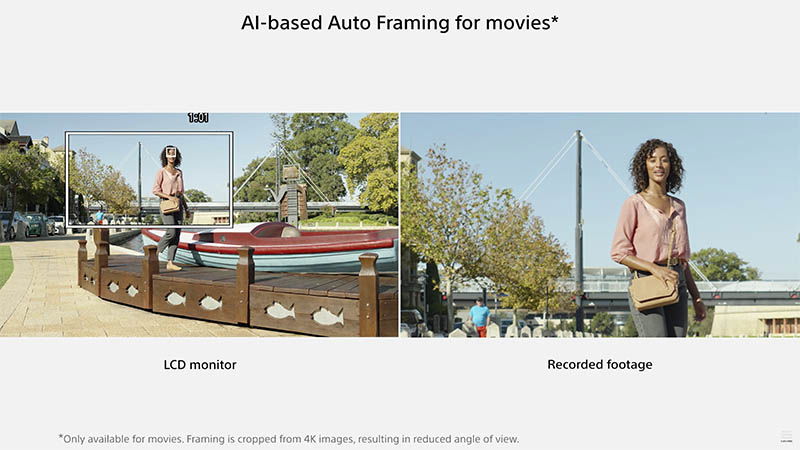
In-camera Time-Lapse / Interval Shooting
The in-camera time-lapse function allows you to create time-lapse videos within the camera itself, with the a6400 this was only possible by using post editing software.
Stabilization
The a6400 does not feature Sony’s In-Body Stabilization (IBIS) but it does support E-mount lenses that have optical stabilization (OSS) built-in.
The a6700 does feature Sony’s In-Body Stabilization (IBIS). The 5-axis in-body optical image stabilization mechanism detects and compensates for camera shake along five different axes, including angular (pitch and yaw), horizontal, vertical and rotational, for stabilization equivalent to a 5-step faster shutter speed setting.

As mentioned previously, the a6700 also features Active Mode Enhanced Movie Image Stabilization which is not available on the a6400.
This applies a 1.13x crop to the footage and allows the camera to move the crop around, within the standard video regions, to correct for more dramatic motion than the sensor shift alone can provide.
The camera’s gyro data is saved into the video file so that you can apply more powerful digital correction (or less correction, less crop), in Sony’s Catalyst software.
Autofocus
The Sony a6400 features a Fast Hybrid AF system that combines phase-detection AF and contrast-detection AF to achieve a super-fast acquisition speed of just 0.02 seconds.
The a6700 is equipped with an AI processing unit that enhances its AF performance compared to the a6400, including much more accurate subject recognition and a wider range of subjects.
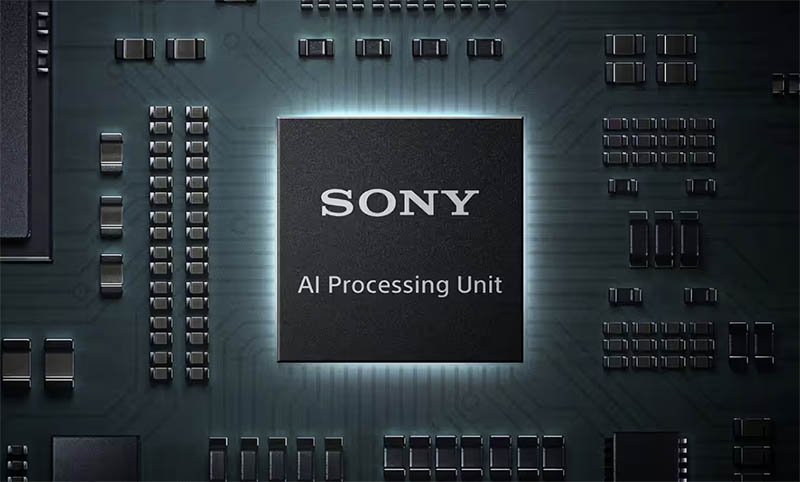
In addition to humans and animals that the a6400 is capable of tracking, the a6700 will recognize birds, insects, cars, trains and airplanes.
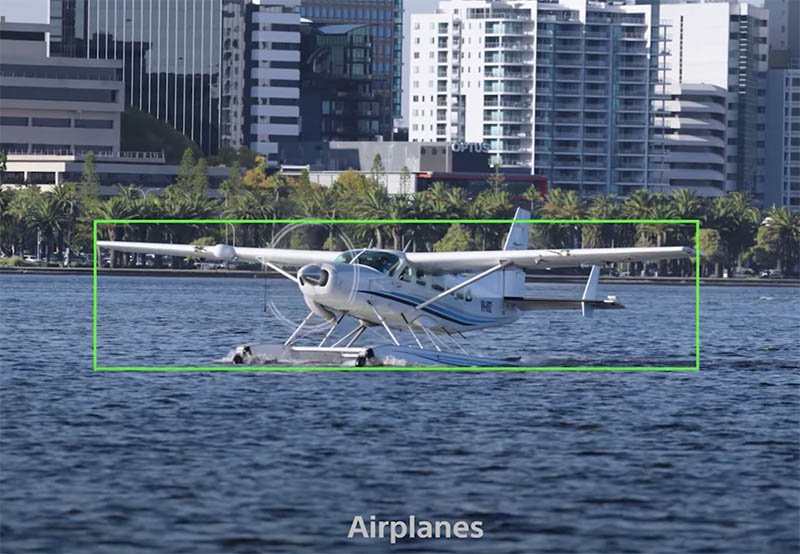
Heads and bodies are recognized in addition to eyes (Real-time Eye AF) for Human and Animal settings, and now for Birds as well. Animal recognition performance has been improved by 40% compared to the a6400.
Phase & Contrast Detection Points
The Sony a6400 features 425 phase and 425 contrast detection AF points that cover 84% of the image area.
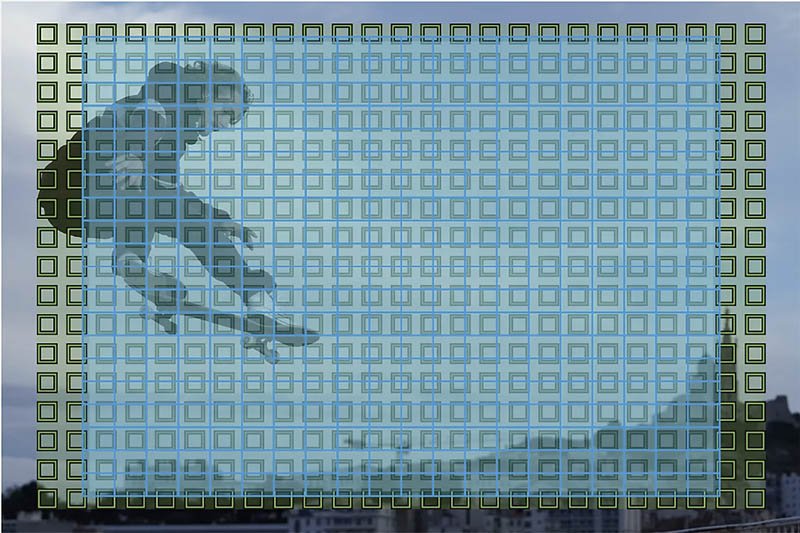
The a6700 improves on this with up to 759 phase detection points, covering approximately 93% of the image area when shooting stills. For shooting movies this reduces to a maximum of 495 points.

Lowlight AF Performance
When focusing in low light the Sony a6700 has a one stop advantage over the a6400:
- A6400: EV-2 to EV20 (ISO100 equivalent with F2.0 lens attached)
- A6700: EV-3 to EV20 (ISO100 equivalent with F2.0 lens attached)
Shutter
Both the A6400 and a6700 feature a Mechanical / Electronic shutter with a shutter speed of 1/4000 to 30s for stills and 1/4000 to 1/4 for movies.
However, the a6700 goes one step further and offers the advantage of capturing shots at an impressive speed of 1/8000 sec when utilizing the electronic shutter.
Additionally, the a6700 introduces support for Variable Shutter, allowing users to manually adjust the shutter speed and observe the effects of flickering on the camera’s monitor. This feature is available for both still photography and video recording.
Drive Speed & Buffer
If you enjoy shooing action, sports or birds in flight then you’d definitely want to take note of the drive speed (frames per second) along with the shot buffer.
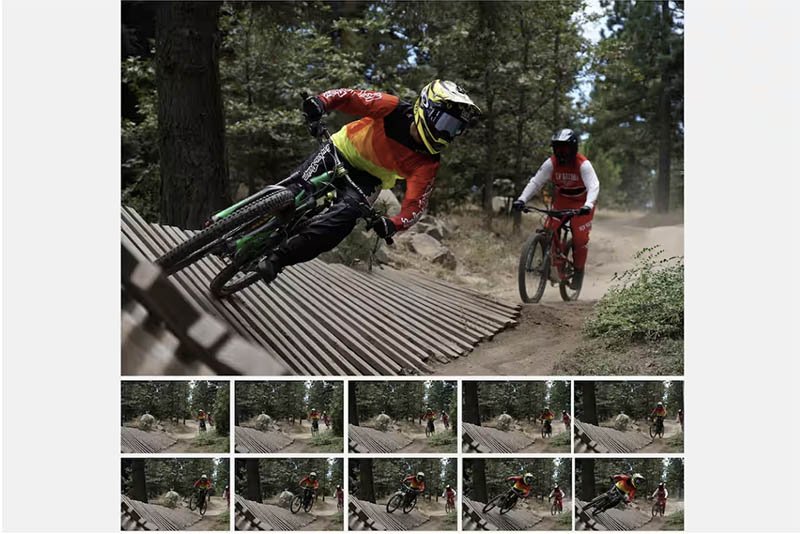
Both the a6400 and a6700 support a maximum frame rate of 11 fps when shooting in Hi+ with their mechanical shutters, so no difference here. However, if you want to shoot silently with the electronic shutter then only the a6700 can maintain 11 fps, the a6400 drops down to 8 fps.
Buffer
There is a much larger difference between the two cameras when we compare the size of their image buffers, with the a6700 coming out on top.
| JPEG L Extra Fine | Compressed RAW | Lossless Compressed RAW | HEIF | |
|---|---|---|---|---|
| A6400 | 99 Shots | 46 Shots | – | – |
| A6700 | 143 Shots | 59 Shots | 23 Shots |
Electronic Viewfinder and LCD Display
Both cameras feature an electronic viewfinder (EVF) as well as a touch friendly LCD display.
Electronic Viewfinder (EVF)
Looking at the specs the EVF appears to be similar between the two cameras, other than a slight difference in the eyepoint.
However, according to Sony the EVF of the a6700 has twice the brightness of the a6400 and a wider 33-degree viewing angle.
| Sony A6400 | Sony a6700 | |
|---|---|---|
| EVF Type | 1.0 cm (0.39 type) electronic viewfinder (color) | 1.0 cm (0.39 type) electronic viewfinder (XGA OLED) |
| Field Coverage | 100 % | 100 % |
| EVF Resolution | 2,359,296 dots | 2,359,296 dots |
| EVF Magnification | Approx. 1.07x (35mm camera equivalent: Approx. 0.70x) with 50mm lens at infinity, -1m-1 | Approx. 1.07x (35 mm camera equivalent: Approx. 0.70x) with 50 mm lens at infinity, -1 m-1 |
| EVF Eyepoint | Approx. 0.91 inches (23 mm) from the eyepiece lens, 0.84 inches (21.4 mm) from the eyepiece frame at -3.28 feet (-1 m)-1 (CIPA standard) | Approx. 22 mm from the eyepiece lens, 19.4 mm from the eyepiece frame at -1 m-1 (CIPA standard) |
| Refresh Rate | NTSC mode: STD 60fps / HI 120fps, PAL mode: STD 50fps / HI 100fps | NTSC mode: STD 60fps / HI 120fps, PAL mode: STD 50fps / HI 100fps |
LCD Display
The Sony a6400 will let you rotate the screen up 180° making it so much easier to frame yourself for selfies and vlogging.
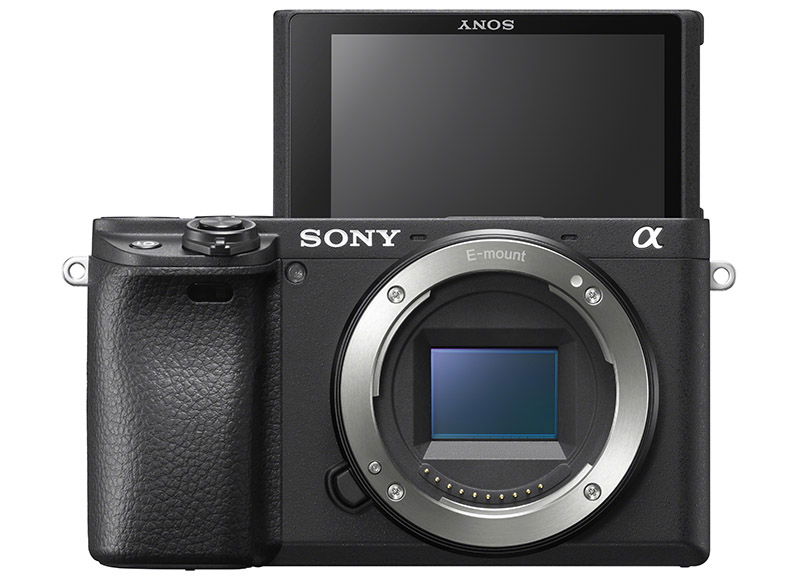
This is great for Vlogging as demonstrated nicely by iJustine in the below video.
The Sony a6700 features an improved LCD design over the a6400. The resolution only sees a very modest increase to 1 036 800 dots, but the biggest change here is in its movement.
The LCD can be flipped out to the side and rotated approx. 270 °. Helping you to comfortably shoot from a variety of positions.
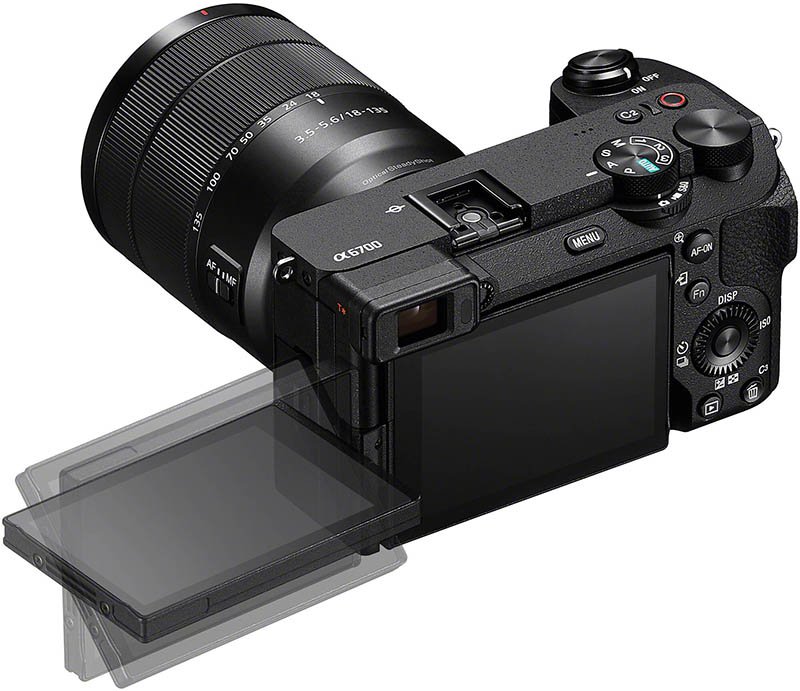
Improved Menu and Touch Control
The a6400 features an older and less intuitive menu design which is often complained about although personally I’ve never found it too difficult to navigate.
The a6700 benefits from the latest menu updates and touch functionality that have been incorporated into cameras like the a7IV and a7RV. These advancements in user interface and touch controls help to ensure a more intuitive and user-friendly experience.

You can easily activate key functions, such as selecting a focus point or subject to track, or triggering the shutter.
Swiping in from the left or right edge of the shooting display reveals touch icons that allow quick changes to the shooting mode and other settings.
The function (Fn) menu can also now be displayed by a simple swipe-up.
Camera Body & Controls
Both cameras share a similar body but they are not identical, with the a6700 offering some key control improvements over the a6400 as well as some extra weight and bulk.
The dimensions are as follows:
- A6400: W/H/D: Approx. 120.0 mm x 66.9 mm x 59.7 mm, (Approx. 14.3 oz / 403 g)
- A6700: W/H/D: 122.0 x 69.0 x 75.1 mm, (approx. 493 g / Approx. 1 lb 1.4 oz)
Sony A6400
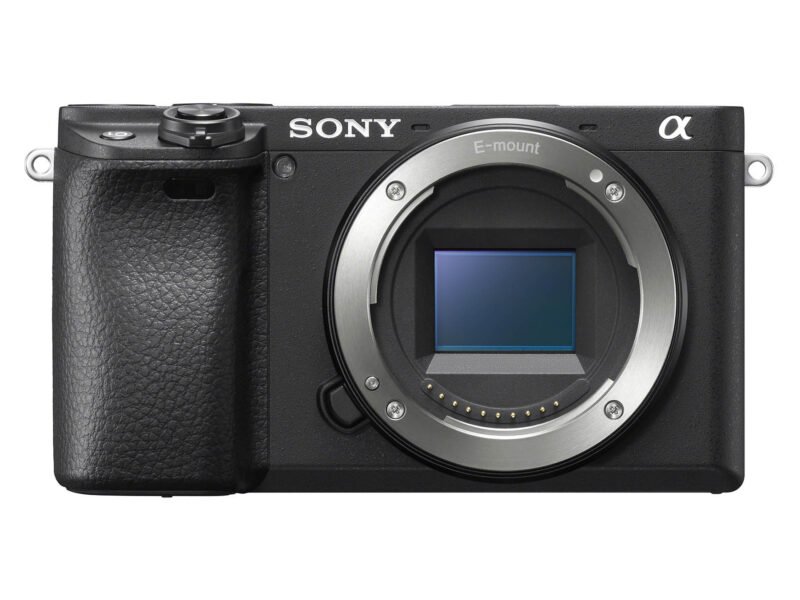
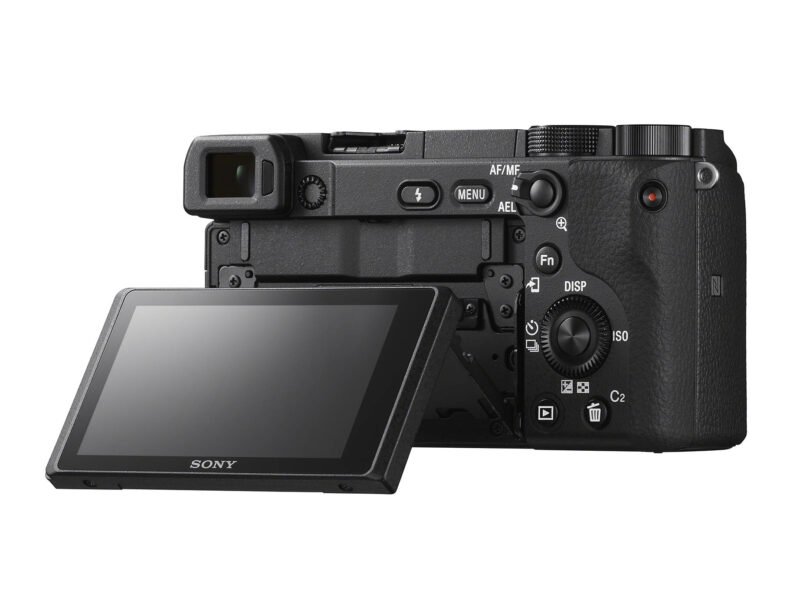

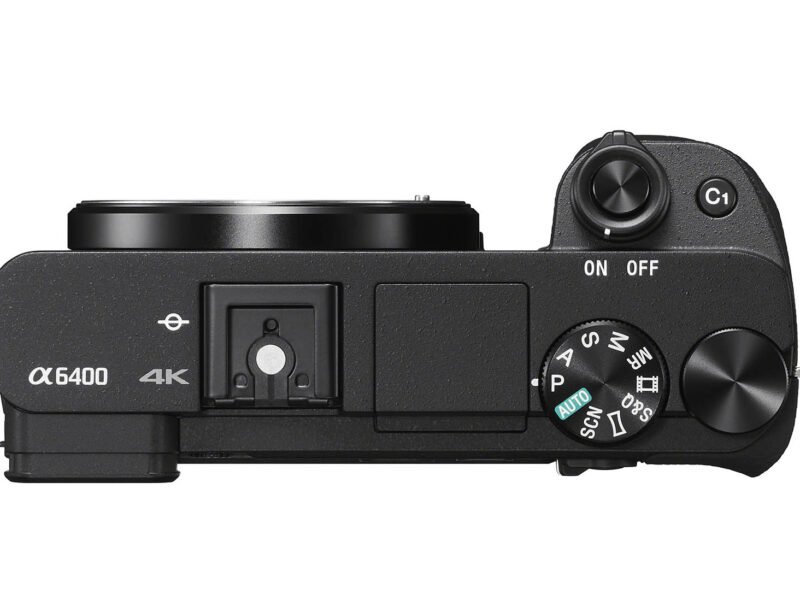

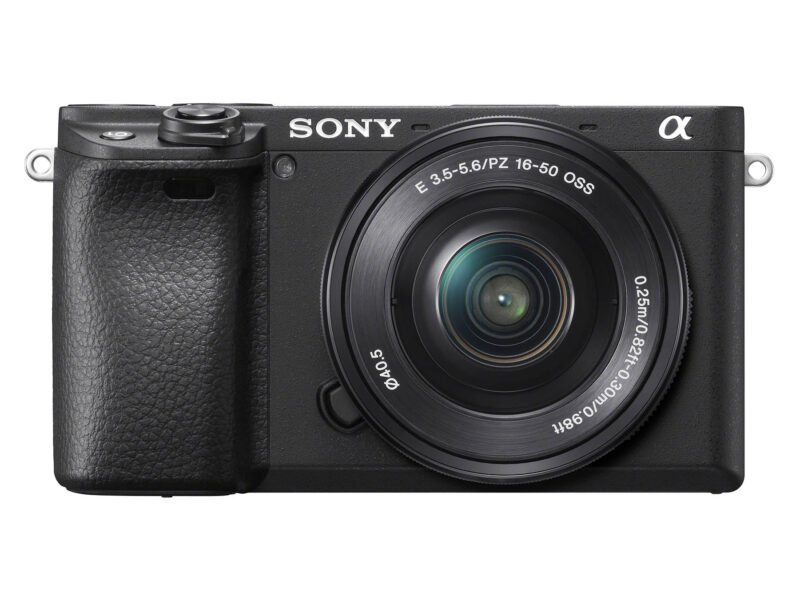

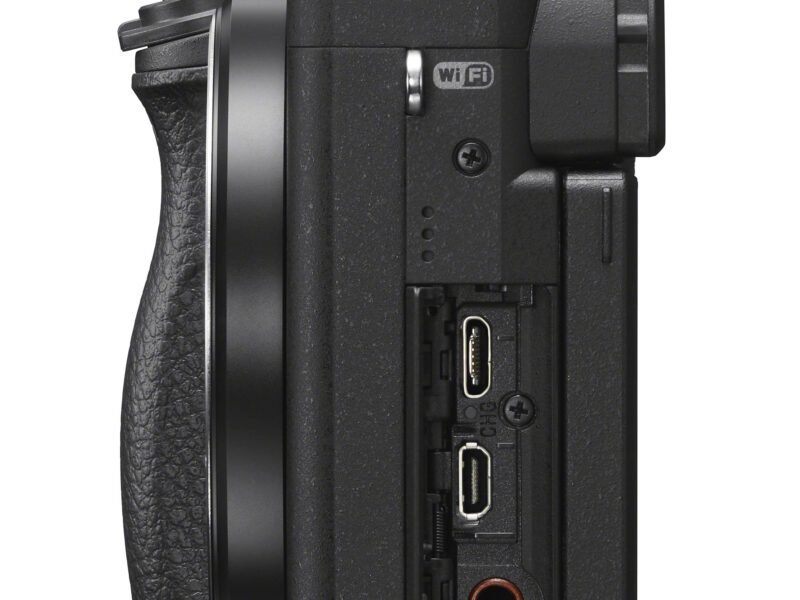
Sony A6700
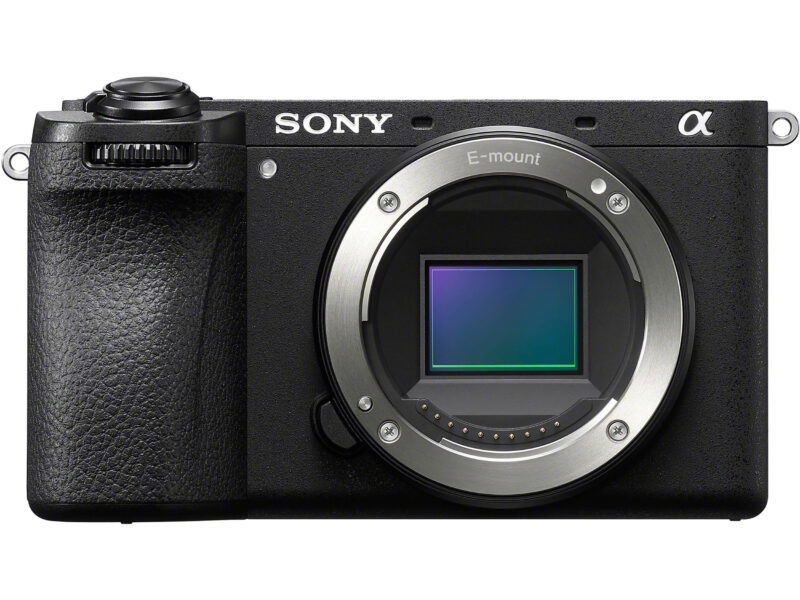
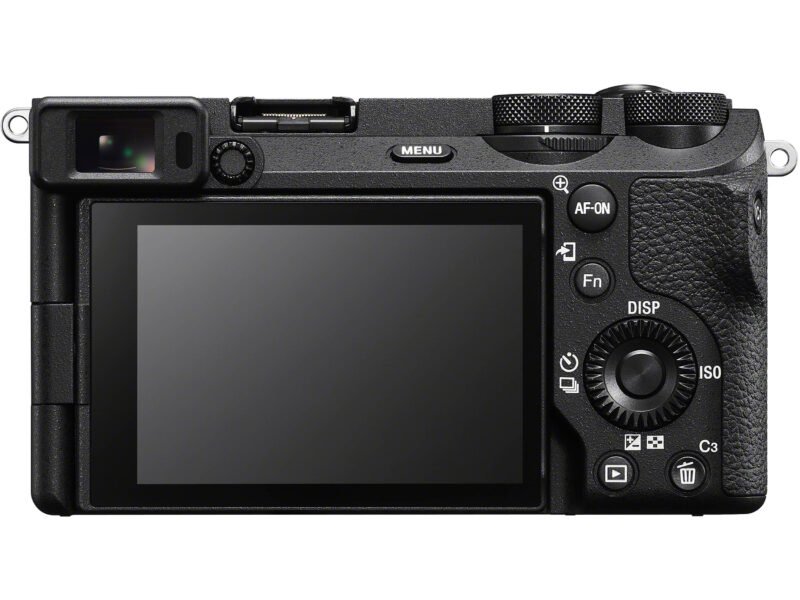
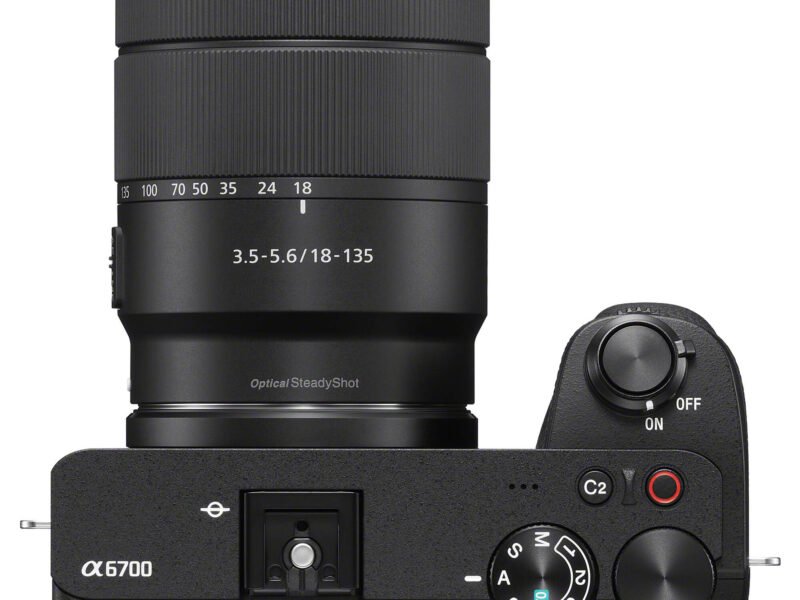

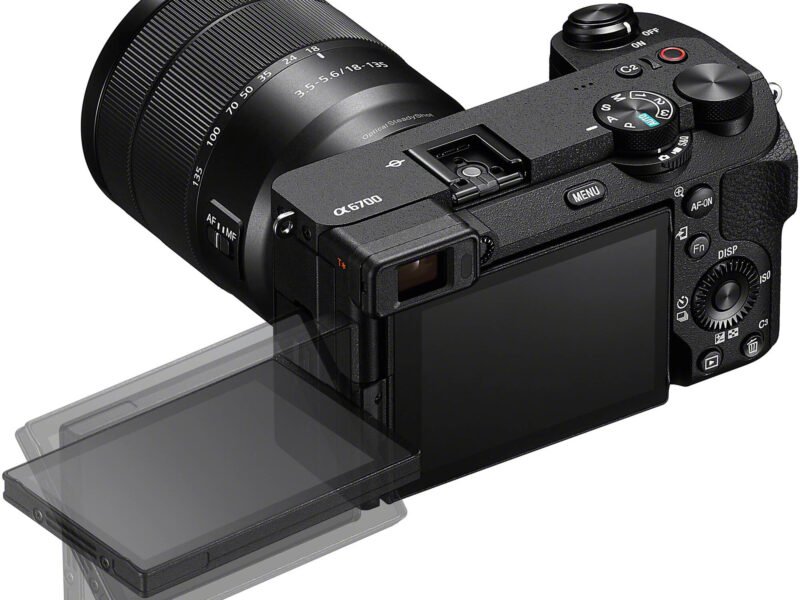
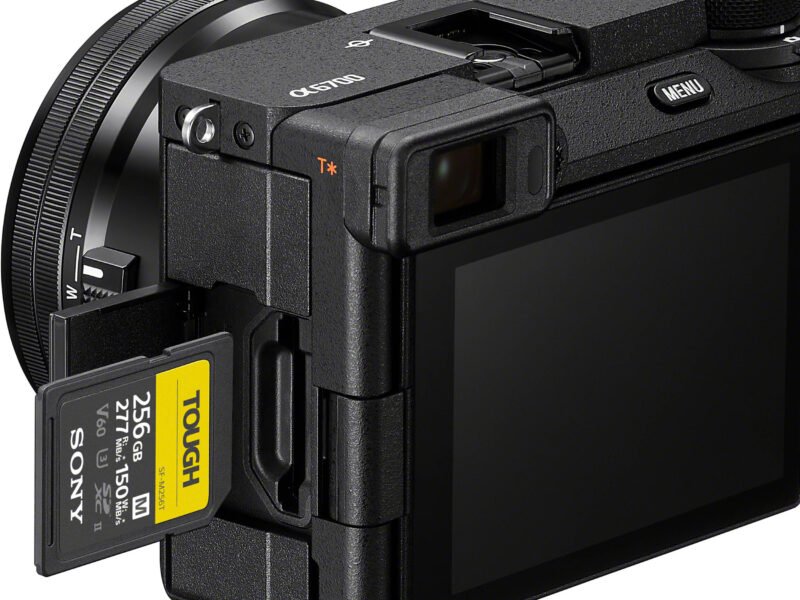
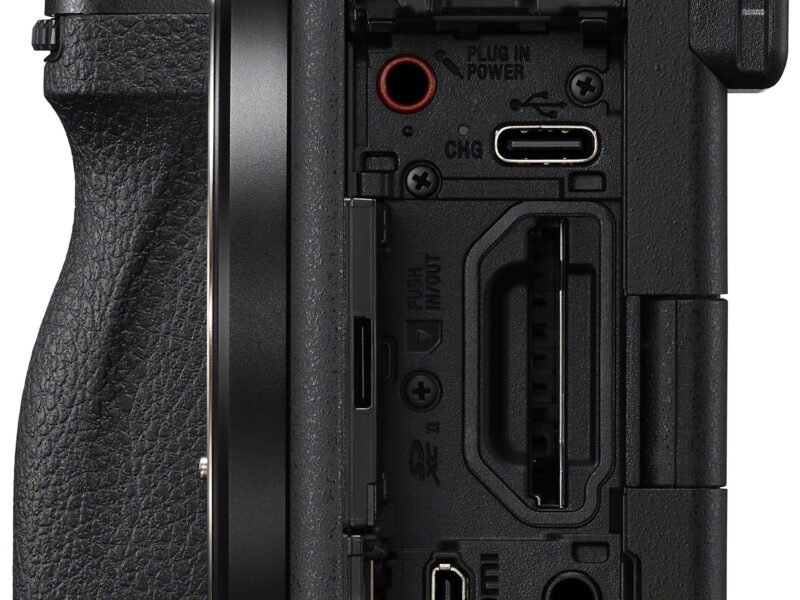


Most notable difference is that the a6700 has a front control wheel which is absent from the a6400. This makes the a6700 a lot more comfortable for shooters who switch between full-frame and APS-C bodies.
On the top of the a6700 you will find a dedicated movie record button and C2 (custom) button. The movie record button is located on the side of the a6400, this is the C1 button on the a6700.
There’s an extra dial on the a6700 below the main mode dial that allows you to have 3 dedicated memories for stills, movies and S&Q. This very useful feature is not available on the a7III and you are un able to set individual settings for movies and stills.
On the rear of the cameras the AF/MF switch on the a6400 is instead an AF-On button on the a6700.
Full-time DMF
Full-time DMF is only available on the a6700. This works when shooting stills with AF-C or AF-S autofocus. With DMF you can rotate the lens’s focus ring to switch to manual focus mode at any time, making switching focus on the fly super easy and fast. The a6400 does not support full-time DMF unless you have a lens that supports this feature.
Focus Bracketing
Focus bracketing is another new feature that you’ll find on the a6700 but not the a6400.
With focus bracketing the a6700 can automatically shoot up to 299 images with sequentially shifted focus points according to intervals and a sequence specified by you. Unfortunately there is no option to automatically combine images in-camera, this needs to be done in post.
This video from Mark Galer explains more about how focus bracketing works with the a7RV, but it’s very similar for the a6700.
Flicker Suppression
The a6700 provides options for flicker suppression from artificial lighting whether you’re shooting stills or movies. Simply select “Anti-flicker Shoot”, or use “Var. Shutter” to fine-tune shutter speeds to match flicker rates when filming.
Memory Cards
The a6400 feature a single memory card slot that supports Memory Stick PRO Duo, Memory Stick PRO-HG Duo, Memory Stick Micro (M2), SD memory card, SDHC memory card (UHS-I compliant), SDXC memory card (UHS-I compliant), microSD memory card, microSDHC memory card, and microSDXC memory cards (with an adapter).
The a6700 also includes a single memory card slot but this supports the much faster UHS-II SD cards along with UHS-I SD cards. The memory card slot is located on the side of the camera making is much more accessible from the shared battery port location of the a6400.
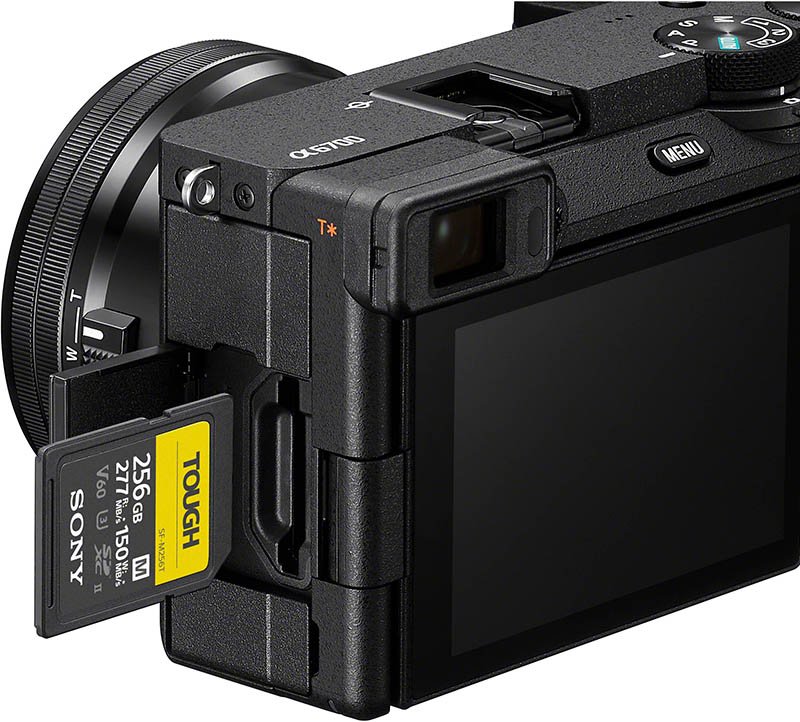
Load / Save Settings (CAMSET)
For this first time in the a6xxx Series you can now save/load camera settings to/from a memory card. You can save up to 10 settings per memory card. You can also load settings from another camera of the same model.
The a6400 offers a more basic option that allows you to save up to 4 (M1 through M4) to a memory card, then recall the settings using the mode dial.
Battery Life & USB Charging
The a6400 uses the smaller capacity Sony NP-FW50 rechargeable battery, whereas the a6700 uses the larger capacity Sony NP-FZ100 rechargeable battery.
Shooting stills the a6400 achieves approx. 360 shots (Viewfinder) and approx. 410 shots (LCD monitor) (CIPA standard) with a full battery. Shooting movies (actual) will get you approx. 70 min (Viewfinder) or approx. 75 min (LCD monitor) (CIPA standard).
Thanks to the larger capacity battery the a6700 can achieve approx. 550 shots (Viewfinder) and approx. 570 shots (LCD monitor) (CIPA standard). Shooting movies (actual) will get you approx. 95 min (Viewfinder) or approx. 100 min (LCD monitor) (CIPA standard).
The a6700 is equipped with USB PD (Power Delivery) support, enabling rapid battery charging directly within the camera. Compared to earlier models, this feature delivers 3 to 4 times more power, significantly reducing charging times. By connecting a USB charger or a USB PD-compatible power bank to the camera’s USB Type-C port, you can greatly extend your shooting sessions.
Live Streaming / Webcam
The Sony a6400 does not support live streaming in-camera but it can be used as a webcam when using Sony’s Imaging Edge Webcam software, the resolution is however limited to 1,024 × 576 pixels.
With the a6700 you just need to connect the camera to a computer or smartphone via USB, then select “Live Stream (USB Streaming)”.
The a6700 can also function as a 4K (2160p) webcam with advanced AF that makes online meetings and live streaming events even smoother.
Firmware Updates
Updating the a6400 firmware is only possible by connecting the camera to your computer via USB. For Mac OS users this has always been a nightmare since it triggers security flags and can be very difficult to install. For Windows users life is a little easier.
Thankfully the a6700 enables firmware updates via memory card which is a lot less painful. Most new cameras from Sony are now offering this option.
Connectivity
The a6400 supports 2.4 Ghz wireless connections and bluetooth. There’s a Multi/Micro Hi-Speed USB (USB 2.0) terminal and a HDMI micro connector. There’s also a 3.5 mm Stereo minijack for a microphone but no headphone jack.
The a6400 can be controlled remotely using the Imaging Edge Mobile App but functionality is limited. The Sony RMT-P1BT Bluetooth Remote (B&H Photo | Amazon) is also supported.
The a6700 supports Sony’s newer Creators App for remote control and file management.
The Sony RMT-P1BT Bluetooth Remote (B&H Photo | Amazon) is also supported by both cameras.
The a6400 features the previous-generation multi-interface shoe design, while the a6700 incorporates the latest Multi Interface (MI) Shoe. This updated shoe allows for cable-free connectivity, enabling direct transmission of digital audio signals without any loss in quality. Additionally, it provides power to connected devices, eliminating the need for separate microphone batteries.
The a6700 supports 2.4 Ghz / 5 Ghz wireless connections and bluetooth. However, whereas the a6400 supports USB 2.0 (480 Mb/s), the a6700 supports SuperSpeed USB 5 Gbps (USB 3.2) for even faster data transfer.
The a6700 also has a 3.5 mm Stereo minijack for a microphone and a 3.5mm stereo minijack for headphones along with the HDMI micro connector.
What’s in the Box
The box contents of each camera are very similar except the a6700 does not include the AC-UUD12 AC Adaptor or a Micro USB cable.
| Sony A6400 | Sony A6700 |
|---|---|
| Sony a6400 body | Sony A6700 Body |
| Power cord | Rechargeable Battery NP-FZ100 |
| Rechargeable Battery NP-FW50 | Shoulder strap |
| AC Adaptor: AC-UUE12 | Body cap |
| Shoulder strap | Accessory shoe cap |
| Body cap | Eyepiece cup |
| Accessory shoe cap | |
| Eyepiece cup | |
| Micro USB cable |
Price
The A6700 costs around $500 more than the A6400. There are often price reductions so please check the latest prices with the links below.
The A6400 has an MRRP of: $898.00 / £899.00
The A6700 has an MRRP of: $1,398.00 / £1,449.00
Summary
The a6700 offers a lot for video shooters with 4K60p / 4K120p, In-body Stabilization and an excellent vari-angle LCD. Superior autofocus performance and subject tracking will also help you to track and capture more difficult subjects. On the other hand, the a6400 despite its age still provides excellent value for money.
Here are the key features from the A6700 that you won’t find on the A6400:
- 26 MP back-illuminated sensor
- BIONZ XR processor
- 4k60p / 4k120p
- S&Q 240 FPS in FHD
- 5 axis IBIS
- NP-FZ100 battery
- Active Mode enhanced movie image stabilization
- UHS-II SD card support
- Front dial
- USB 3.2 with Power Delivery
- 3 Memory Recalls + CAMSET
- Lossless RAW & HEIF file formats
- 14-bit RAW when shooting long exposure noise reduction and bulb
- 1/8000sec shutter speed (electronic)
- Anti-flicker shooting and variable shutter
- Import User LUT files
- 759 PDAF points
- Real-time tracking of animals, birds, insects, cars/trains, and airplanes
- In-camera time-lapse creation
- Auto framing
- Focus breathing
- Focus bracketing
- Focus map (movies)
- AF Assist
- Full-time DMF
- Touch shutter
- Bulb timer settings
- Firmware updates via memory card
Jumping from the a6400 to the a6600 was never a particularly big upgrade. You would really only benefit from the in-camera stabilization (if important to you) and the larger battery.
However, jumping from the a6400 to the a6700 offers some serious benefits and will most likely appeal to many a6400 shooters who are itching to upgrade.
But are we going to see a replacement for the a6400 anytime soon? I’ve not heard any rumors that a release is close but you can’t rule it out.
If you have the money to spend on the a6700 then this would definitely be my recommendation. It’s a much better camera all-round than the a6400 which is now starting to show its age.
But if you have a tight budget then the a6400 still packs a serious punch and is capable of capturing some amazing images and movies.
Please let me know in the comments below if you found this comparison helpful or if you have any questions.
Finally. Please don’t forget to take a look at our friendly Alpha Shooters Community Forum before you leave. Thank you!
Reviews
To learn more about these two cameras I’d recommend watching the following reviews from Gordon Laing.
Sony A6700 Guides & Resources
Sony A6700 Forum & Facebook Group
If you are looking for further help and advice on the A6700 or would simply like to share your photos and videos, then please head over to our friendly APS-C Forum. If you prefer Facebook then I also run the Sony A6700 + A6600 Shooters Group.
Sony A6400 Guides & Resources
Sony A6400 Forum & Facebook Group
If you are looking for further help and advice on the A6400 or would simply like to share your photos and videos, then please head over to our friendly APS-C Forum. If you prefer Facebook then I also run the Sony a6400 Shooters Group.
Complete Specification Comparison
I don’t like to leave stones unturned so here’s the complete specification comparison between the two cameras.
Body
| Sony A6400 | Sony A6700 | |
|---|---|---|
| Body Type | Mirrorless | Mirrorless |
| Body Material | Magnesium alloy | Magnesium alloy |
| Lens Mount | Sony E-mount | Sony E-mount |
| Lens Compatibility | Sony E-mount lenses | Sony E-mount lenses |
Image Sensor
| Sony A6400 | Sony A6700 | |
|---|---|---|
| Aspect Ratio | 3:2 | 3:2 |
| Number of Pixels (Effective) | Approx. 24.2 megapixels | Still images: Approx. 26.0 megapixels max.,Movies: Approx. 19.9 megapixels max. |
| Number of Pixels (Total) | Approx. 25.0 megapixels | Approx. 27.0 megapixels |
| Sensor Type | APS-C type (23.5 x 15.6mm), Exmor CMOS sensor | APS-C type (23.3 x 15.5 mm), Exmor R CMOS sensor, Back-illuminated |
| Anti-Dust System | Charge protection coating on optical filter and ultrasonic, vibration mechanism | Yes |
Still Images
| Sony A6400 | Sony A6700 | |
|---|---|---|
| Recording Format | JPEG (DCF Ver. 2.0, Exif Ver.2.31, MPF Baseline compliant), RAW (Sony ARW 2.3 format) | JPEG (DCF Ver. 2.0, Exif Ver. 2.32, MPF Baseline compliant), HEIF (MPEG-A MIAF compliant), RAW (Sony ARW 4.0 format compliant) |
| Image Size (Pixels) (3:2) | L: 6000 x 4000 (24M), M: 4240 x 2832 (12M), S: 3008 x 2000 (6.0M) | APS-C L: 6192 x 4128 (26 M), M: 4384 x 2920 (13 M), S: 3104 x 2064 (6.4 M) |
| Image Size (Pixels) (16:9) | L: 6000 x 3376 (20 M), M: 4240 x 2400 (10 M), S: 3008 x 1688 (5.1 M) | |
| Image Size (Pixels) (1:1) | L: 4000 x 4000 (16 M), M: 2832 x 2832 (8.0 M), S: 2000 x 2000 (4.0 M) | |
| Image Quality Modes | RAW, RAW & JPEG (Extra fine, Fine, Standard), JPEG (Extra fine, Fine, Standard) | RAW, JPEG, HEIF (4:2:0 / 4:2:2), RAW & JPEG, RAW & HEIF |
| Picture Effect | 13 types: Posterization (Color), Posterization (B/W), Pop Color, Retro Photo, Partial Color (R/G/B/Y), High Contrast Monochrome, Toy Camera (Normal/Cool/Warm/Green/Magenta), Soft High-key, Soft Focus (High/Mid/Low), HDR Painting (High/Mid/Low), Rich-tone Monochrome, Miniature (Auto/Top/Middle (H)/Bottom/Right/Middle (V)/Left), Watercolor, Illustration (High/Mid/Low) | |
| Creative Style | Standard, Vivid, Neutral, Clear, Deep, Light, Portrait, Landscape, Sunset, Night Scene, Autumn leaves, Black & White, Sepia, Style Box (1-6), (Contrast (-3 to +3 steps), Saturation (-3 to +3 steps), Sharpness (-3 to +3 steps)) | |
| Dynamic Range Functions | Off, Dynamic Range Optimizer (Auto/Level (1-5)), Auto High Dynamic Range (Auto Exposure Difference, Exposure Difference Level (1-6 EV, 1.0 EV step)) | |
| Color Space | sRGB standard (with sYCC gamut) and Adobe RGB standard compatible with TRILUMINOS Color | |
| 14bit RAW | Yes | Yes |
| Uncompressed RAW | No | No |
Movie Recording
| Sony A6400 | Sony A6700 | |
|---|---|---|
| Recording Format | XAVC S: LPCM 2ch, AVCHD: Dolby® Digital (AC-3) 2ch, Dolby® Digital Stereo Creator | |
| Video Compression | XAVC S: MPEG-4 AVC/H.264, AVCHD: MPEG-4 AVC/H.264 | XAVC S: MPEG-4 AVC/H.264,XAVC HS: MPEG-H HEVC/H.265 |
| Audio Recording Format | XAVC S: LPCM 2ch, AVCHD: Dolby Digital (AC-3) 2ch, Dolby Digital Stereo Creator | LPCM 2ch (48 kHz 16 bit)、LPCM 2ch (48 kHz 24 bit)2、LPCM 4ch (48 kHz 24 bit)2 |
| Color Space | xvYCC standard (x.v.Color when connected via HDMI cable) compatible with TRILUMINOS Color | |
| Picture Effect | Posterization (Color), Posterization (B/W), Pop Color, Retro Photo, Partial Color (R/G/B/Y), High Contrast Monochrome, Toy Camera(Normal/Cool/Warm/Green/Magenta), Soft High-key | |
| Creative Style | Standard, Vivid, Neutral, Clear, Deep, Light, Portrait, Landscape, Sunset, Night Scene, Autumn leaves, Black & White, Sepia, Style Box (1-6), (Contrast (-3 to +3 steps), Saturation (-3 to +3 steps), Sharpness (-3 to +3 steps)) | |
| Picture Profile | Yes (Off/PP1-PP10) Parameters: Black level, Gamma (Movie, Still, Cine1-4, ITU709, ITU709 [800%], S-Log2, S-Log3, HLG, HLG1-3), Black Gamma, Knee, Color Mode, Saturation, Color Phase, Color Depth, Detail, Copy, Reset | |
| Image Size (Pixels), NTSC | XAVC S 4K: 3840 x 2160 (30p, 100 M), 3840 x 2160 (24p, 100 M), 3840 x 2160 (30p, 60 M), 3840 x 2160 (24p, 60 M), XAVC S HD: 1920 x 1080 (120p, 100 M), 1920 x 1080 (120p, 60 M), 1920 x 1080 (60p, 50 M), 1920 x 1080 (30p, 50 M), 1920 x 1080 (24p, 50 M), 1920 x 1080 (60p, 25 M), 1920 x 1080 (30p, 16 M), AVCHD: 1920 x 1080 (60i, 24M, FX), 1920 x 1080 (60i, 17M, FH) | |
| Image Size (Pixels), PAL | XAVC S 4K: 3840 x 2160 (25p, 100 M), 3840 x 2160 (25p, 60 M), XAVC S HD: 1920 x 1080 (100p, 100 M), 1920 x 1080 (100p, 60 M), 1920 x 1080 (50p, 50 M), 1920 x 1080 (25p, 50 M), 1920 x 1080 (50p, 25 M), 1920 x 1080 (25p, 16 M), AVCHD: 1920 x 1080 (50i, 24 M, FX), 1920 x 1080 (50i, 17 M, FH) | |
| Movie Recording Format (XAVC HS 4K) | 3840 x 2160 (4:2:0, 10bit) (Approx.):119.88p (200 Mbps),3840 x 2160 (4:2:0, 10bit) (Approx.):100p (200 Mbps),3840 x 2160 (4:2:0, 10bit) (Approx.):59.94p (150 Mbps / 75 Mbps / 45 Mbps),3840 x 2160 (4:2:0, 10bit) (Approx.):50p (150 Mbps / 75 Mbps / 45 Mbps),3840 x 2160 (4:2:0, 10bit) (Approx.):23.98p (100 Mbps / 50 Mbps / 30 Mbps),3840 x 2160 (4:2:2, 10bit) (Approx.):119.88p (280 Mbps),3840 x 2160 (4:2:2, 10bit) (Approx.):100p (280 Mbps),3840 x 2160 (4:2:2, 10bit) (Approx.):59.94p (200 Mbps / 100 Mbps),3840 x 2160 (4:2:2, 10bit) (Approx.):50p (200 Mbps / 100 Mbps),3840 x 2160 (4:2:2, 10bit) (Approx.):23.98p (100 Mbps / 50 Mbps) | |
| Movie Recording Format (XAVC S 4K) | 3840 x 2160 (4:2:0, 8bit) (Approx.):119.88p (200 Mbps),3840 x 2160 (4:2:0, 8bit) (Approx.):100p (200 Mbps),3840 x 2160 (4:2:0, 8bit) (Approx.):59.94p (150 Mbps),3840 x 2160 (4:2:0, 8bit) (Approx.):50p (150 Mbps),3840 x 2160 (4:2:0, 8bit) (Approx.):29.97p (100 Mbps / 60 Mbps),3840 x 2160 (4:2:0, 8bit) (Approx.):25p (100 Mbps / 60 Mbps),3840 x 2160 (4:2:0, 8bit) (Approx.):23.98p (100 Mbps / 60 Mbps),3840 x 2160 (4:2:2, 10bit) (Approx.):119.88p (280 Mbps),3840 x 2160 (4:2:2, 10bit) (Approx.):100p (280 Mbps),3840 x 2160 (4:2:2, 10bit) (Approx.):59.94p (200 Mbps),3840 x 2160 (4:2:2, 10bit) (Approx.):50p (200 Mbps),3840 x 2160 (4:2:2, 10bit) (Approx.):29.97p (140 Mbps),3840 x 2160 (4:2:2, 10bit) (Approx.):25p (140 Mbps),3840 x 2160 (4:2:2, 10bit) (Approx.):23.98p (100 Mbps) | |
| Movie Recording Format (XAVC S HD) | 1920 x 1080 (4:2:0, 8bit) (Approx.):119.88p (100 Mbps / 60 Mbps),1920 x 1080 (4:2:0, 8bit) (Approx.):100p (100 Mbps / 60 Mbps),1920 x 1080 (4:2:0, 8bit) (Approx.):59.94p (50 Mbps / 25 Mbps),1920 x 1080 (4:2:0, 8bit) (Approx.):50p (50 Mbps / 25 Mbps),1920 x 1080 (4:2:0, 8bit) (Approx.):29.97p (50 Mbps / 16 Mbps),1920 x 1080 (4:2:0, 8bit) (Approx.):25p (50 Mbps / 16 Mbps),1920 x 1080 (4:2:0, 8bit) (Approx.):23.98p (50 Mbps),1920 x 1080 (4:2:2, 10bit) (Approx.):59.94p (50 Mbps),1920 x 1080 (4:2:2, 10bit) (Approx.):50p (50 Mbps),1920 x 1080 (4:2:2, 10bit) (Approx.):29.97p (50 Mbps),1920 x 1080 (4:2:2, 10bit) (Approx.):25p (50 Mbps),1920 x 1080 (4:2:2, 10bit) (Approx.):23.98p (50 Mbps) | |
| Movie Recording Format (XAVC S-I 4K) | 3840 x 2160 (4:2:2, 10bit) (Approx.):59.94p (600 Mbps),3840 x 2160 (4:2:2, 10bit) (Approx.):50p (500 Mbps),3840 x 2160 (4:2:2, 10bit) (Approx.):29.97p (300 Mbps),3840 x 2160 (4:2:2, 10bit) (Approx.):25p (250 Mbps),3840 x 2160 (4:2:2, 10bit) (Approx.):23.98p (240 Mbps) | |
| Movie Recording Format (XAVC S-I HD) | 1920 x 1080 (4:2:2, 10bit) (Approx.):59.94p (222 Mbps),1920 x 1080 (4:2:2, 10bit) (Approx.):50p (185 Mbps),1920 x 1080 (4:2:2, 10bit) (Approx.):29.97p (111 Mbps),1920 x 1080 (4:2:2, 10bit) (Approx.):25p (93 Mbps),1920 x 1080 (4:2:2, 10bit) (Approx.):23.98p (89 Mbps) | |
| Slow & quick motion (recording frame rate & image size) | NTSC mode: 1920 x 1080 (60p, 30p, 24p), PAL mode: 1920 x 1080 (50p, 25p) | 3840 x 2160 (4:2:2, 10bit) (Approx.):59.94p (600 Mbps),3840 x 2160 (4:2:2, 10bit) (Approx.):50p (500 Mbps),3840 x 2160 (4:2:2, 10bit) (Approx.):29.97p (300 Mbps),3840 x 2160 (4:2:2, 10bit) (Approx.):25p (250 Mbps),3840 x 2160 (4:2:2, 10bit) (Approx.):23.98p (240 Mbps) |
| Slow & Quick Motion (Shooting Frame Rate) | NTSC mode: 1fps, 2fps, 4fps, 8fps, 15fps, 30fps, 60fps, 120fps, PAL mode: 1fps, 2fps, 3fps, 6fps, 12fps, 25fps, 50fps, 100fps, | 1920 x 1080 (4:2:2, 10bit) (Approx.):59.94p (222 Mbps),1920 x 1080 (4:2:2, 10bit) (Approx.):50p (185 Mbps),1920 x 1080 (4:2:2, 10bit) (Approx.):29.97p (111 Mbps),1920 x 1080 (4:2:2, 10bit) (Approx.):25p (93 Mbps),1920 x 1080 (4:2:2, 10bit) (Approx.):23.98p (89 Mbps) |
| Movie Functions | Audio Level Display, Audio Rec Level, PAL/NTSC Selector, Proxy Recording (1280 x 720 (Approx. 9 Mbps)), TC/UB (TC Preset/UB Preset/TC Format/TC Run/TC Make/UB Time Rec), Auto Slow Shutter, REC Control, Clean HDMI Info. (ON/OFF selectable), Gamma Disp. Assist | S&Q Mode, Proxy Recording, TC / UB |
| HDMI Output | 3840 x 2160 (30p), 3840 x 2160 (25p), 3840 x 2160 (24p), 1920 x 1080 (60p), 1920 x 1080 (60i), 1920 x 1080 (50p), 1920 x 1080 (50i), 1920 x 1080 (24p), YCbCr 4:2:2 8 bit / RGB 8 bit |
Recording System
| Sony A6400 | Sony A6700 | |
|---|---|---|
| Location Information Link From Smartphone | Yes | Yes |
| Media | Memory Stick PRO Duo, Memory Stick PRO-HG Duo, Memory Stick Micro (M2), SD memory card, SDHC memory card (UHS-I compliant), SDXC memory card (UHS-I compliant), microSD memory card, microSDHC memory card, microSDXC memory card | UHS-I/II compliantSD cards |
| Memory Card Slot | Multi-slot reader for Memory Stick Duo™/SD memory card | Slot for SD (UHS-I/II compliant) memory card |
| Recording Mode on Two Memory Cards | – | – |
Noise Reduction
| Sony A6400 | Sony A6700 | |
|---|---|---|
| Noise reduction | Auto/ ISO 100 to 102400 | |
| Multi Frame NR | Long exposure NR: On/Off, available at shutter speeds longer than 1 sec., High ISO NR: Normal/Low/Off |
White Balance
| Sony A6400 | Sony A6700 | |
|---|---|---|
| White Balance Modes | Auto / Daylight / Shade / Cloudy / Incandescent / Fluorescent (Warm White / Cool White / Day White / Daylight) / Flash / Underwater / Color Temperature (2500 to 9900K) & color filter (G7 to M7 (57-step), A7 to B7 (29-step)) / Custom | |
| Shutter AWB Lock | Yes (Shut. Halfway Down/ Cont. Shooting/ Off) | |
| AWB micro adjustment | Yes (G7 to M7, 57-step)(A7 to B7, 29-step) | |
| Priority set in AWB | Yes | |
| Bracketing | 3 frames, H/L selectable |
Focus
| Sony A6400 | Sony A6700 | |
|---|---|---|
| Focus Type | Fast Hybrid AF (phase-detection AF/contrast-detection AF) | Fast Hybrid AF (phase-detection AF / contrast-detection AF) |
| Focus Sensor | Exmor® CMOS sensor | |
| Focus Point | 425 points (phase-detection AF) / 425 points (contrast-detection AF) | Still images: Max. 759 points (phase-detection AF),Movies: Max. 495 points (phase-detection AF) |
| Focus Sensitivity Range | EV-2 to EV 20 (ISO 100 equivalent with F2.0 lens attached) | EV-3 to EV20 (ISO100 equivalent with F2.0 lens attached) |
| Recognition Target (Still Images) | Human, Animal | Human, Animal, Bird, Insect, Car, Train, Airplane |
| Recognition Target (Movies) | Human | Human, Animal, Bird, Insect, Car, Train, Airplane |
| Focus Mode | AF-A (Automatic AF), AF-S (Single-shot AF), AF-C (Continuous AF), DMF (Direct Manual Focus), Manual Focus | |
| Focus Area | Wide (425 points (phase-detection AF), 425 points (contrast-detection AF)) / Zone / Center / Flexible Spot (S/M/L) / Expanded Flexible Spot / Tracking ( Wide / Zone / Center / Flexible Spot (S/M/L) / Expanded Flexible Spot) | |
| Eye-AF | Human / Animal | Human / Animal / Birds/ Insects |
| Other Features | Eye-start AF (only with LA-EA2 or LA-EA4 attached (Sold separately)), Object Tracking, Eye AF (Right/Left Eye Select), AF micro adjustment with LA-EA2 or LA-EA4 (Sold separately), Predictive control, Focus lock, Swt. V/H AF Area, AF Area Regist., Circ. of Focus Point | AF Track Sens. (Still),AF Subj. Shift Sensitivity (Movie),AF Transition Speed (Movie),Switch V/H AF Area,AF Area Regist.,Circ. of Focus Point,Focus Map (Movie),AF Assist (Movie) |
| AF Illuminator | Yes (with built-in LED type) | Yes (with Built-in LED type) |
| AF Illuminator Range | Approx. 0.3–approx. 3.0 m (with E PZ 16–50 mm F3.5–5.6 OSS lens attached) | |
| Focus Type with LA-EA3 (sold separately) | Phase-detection |
Exposure
| Sony A6400 | Sony A6700 | |
|---|---|---|
| Metering Type | 1200-zone evaluative metering | 1200-zone evaluative metering |
| Metering Sensor | Exmor® CMOS sensor | |
| Metering Sensitivity | EV-2 to EV20 (at ISO100 equivalent with F2.0 lens attached) | EV-3 to EV20 (ISO100 equivalent with F2.0 lens attached) |
| Metering Mode | Multi-segment, Center-weighted, Spot, Spot Standard/Large, Entire Screen Avg., Highlight | |
| Exposure Compensation | +/- 5.0 EV (1/3 EV, 1/2 EV steps selectable) | +/- 5.0 EV (1/3 EV, 1/2 EV steps selectable) |
| Exposure Bracketing | Bracket: Cont., Bracket: Single, 3/5/9 frames selectable. With 3 or 5 frames, in 1/3, 1/2, 2/3, 1.0, 2.0, or 3.0 EV increments, with 9 frames, in 1/3, 1/2, 2/3, or 1.0 EV increments. | |
| AE Lock | Locked when shutter button is pressed halfway. Available with AE lock button. (On/Off/Auto) | |
| Exposure Modes | AUTO (iAuto/Superior Auto), Programmed AE (P), Aperture priority (A), Shutter-speed priority (S), Manual (M), Movie (Programmed AE (P) / Aperture priority (A) / Shutter-speed priority (S) / Manual (M)), Slow & Quick Motion (Programmed AE (P) / Aperture priority (A) / Shutter-speed priority (S) / Manual (M)), Sweep Panorama, Scene Selection | |
| ISO Sensitivity (Recommended Exposure Index) | Still images: ISO 100-32000 (ISO numbers up to ISO 102400 can be set as expanded ISO range.), AUTO (ISO 100-6400, selectable lower limit and upper limit), Movies: ISO 100-32000 equivalent, AUTO (ISO 100-6400, selectable lower limit and upper limit) | Still images: ISO 100 – 32000 (expandable to ISO 50 – 102400), AUTO (ISO 100 – 6400, selectable lower limit and upper limit),Movies: ISO 100 – 32000 equivalent, AUTO (ISO 100 – 6400, selectable lower limit and upper limit) |
| Anti Flicker Shooting | – | Yes |
| Scene Selection | Portrait, Sports Action, Macro, Landscape, Sunset, Night Scene, handheld Twilight, Night Portrait, Anti-Motion Blur |
Viewfinder
| Sony A6400 | Sony A6700 | |
|---|---|---|
| Viewfinder Type | 1.0 cm (0.39 type) electronic viewfinder (color) | 1.0 cm (0.39 type) electronic viewfinder (XGA OLED) |
| Number of Dots | 2,359,296 dots | 2 359 296 dots |
| Brightness Control | Auto/Manual (5 steps between -2 and +2) | |
| Color Temperature Control | Manual (5 steps) | |
| Field Coverage | 100% | |
| Magnification | Approx. 1.07x (35 mm camera equivalent: Approx. 0.70x) with 50 mm lens at infinity, -1m-1 | Approx. 1.07x (35 mm camera equivalent: Approx. 0.70x) with 50 mm lens at infinity, -1 m-1 |
| Dioptre Adjustment | -4.0-+3.0 m-1 | -4.0 to +3.0 m-1 |
| Eye Point | Approx. 0.91 inches (23 mm) from the eyepiece lens, 0.84 inches (21.4 mm) from the eyepiece frame at -3.28 feet (-1 m)-1 (CIPA standard) | Approx. 22 mm from the eyepiece lens, 19.4 mm from the eyepiece frame at -1 m-1 (CIPA standard) |
| Finder Frame Rate Selection | NTSC mode: STD 60fps / HI 120fps, PAL mode: STD 50fps / HI 100fps | NTSC mode: STD 60fps / HI 120fps, PAL mode: STD 50fps / HI 100fps |
| Display Contents | Graphic Display, Display All Info, No Display Info, Digital Level Gauge, Histogram |
LCD Screen
| Sony A6400 | Sony A6700 | |
|---|---|---|
| Monitor Type | 2.95 in (3.0-type) wide type TFT | 7.5 cm (3.0-type) type TFT |
| Number of Dots | 921 600 dots | 1 036 800 dots |
| Touch Panel | Yes | Yes |
| Brightness Control | Manual (5 steps between -2 and +2), Sunny Weather mode | |
| Adjustable Angle | Up by approx. 180 degrees, Down by approx. 74 degrees | Opening Angle: Approx. 176 °, Rotation Angle: Approx. 270 ° |
| Real-time Image Adjustment Display | On/Off | |
| Quick Navi | Yes | |
| Focus Magnifier | Yes Focus Magnifier (5.9x, 11.7x) | |
| Zebra | Yes (selectable level + range or lower limit as custom setting) | |
| Peaking MF | Yes (Level setting: High/Mid/Low/Off, Color: White/Red/Yellow/Blue) | |
| Others | WhiteMagic, Grid Line (Rule of 3rds Grid/Square Grid/Diag. + Square Grid/Off), Movie Marker (Center/Aspect/Safety Zone/Guideframe) | |
| Display Content | Graphic Display, Display All Info, No Disp. Info, Digital Level Gauge, Histogram, For viewfinder, Monitor Off |
Other Features
| Sony A6400 | Sony A6700 | |
|---|---|---|
| Clear Image Zoom | Still images: Approx. 2x, Movies: Approx. 1.5x (4K), Approx. 2x (HD) | Approx. 2x |
| Clear Image Zoom Movies | Approx. 1.5x (4K), Approx. 2x (HD) | |
| Digital Zoom | Smart zoom (Still images): M: Approx. 1.4x, S: Approx. 2x, Digital zoom (Still images): L: Approx. 4x, M: Approx. 5.7x, S: Approx. 8x, Digital zoom (Movie): Approx. 4x | |
| Face Detection | Modes: Face Priority in AF (On/Off), Face Priority in Multi Metering (On/Off), Regist. Faces Priority (On/Off), Face registration, Max. number of detectable: 8 | |
| Self-Portrait Self-Timer | Yes | |
| Others | Interval Recording, Smile Shutter: Smile shutter (selectable from 3 steps), Touch Shutter, Touch Focus: Yes (Touch Focus/Touch Pad/Touch Tracking), ISO AUTO Min. SS, Bright Monitoring, Set File Name, Help guide, Area Setting, Shop Front Mode, Zoom Ring Rotate |
Shutter
| Sony A6400 | Sony A6700 | |
|---|---|---|
| Type | Electronically controlled, vertical-traverse, focal-plane type | Mechanical shutter / Electronic shutter |
| Shutter Speed | Still images: 1/4000 to 30 sec, Bulb, Movies: 1/4000 to 1/4 (1/3 steps), up to 1/60 in AUTO mode (up to 1/30 in Auto slow shutter mode) | Still images (Mechanical shutter): 1/4000 to 30 s, Bulb,Still images (Electronic shutter): 1/8000 to 30 s,Movies: 1/8000 to 1 s |
| Flash Sync. Speed | 1/160 sec. | 1/160 s |
| Electronic Front Curtain Shutter | Yes (ON/OFF) | Yes (ON/OFF) |
| Silent Shooting | Yes (ON/OFF) | Yes (ON/OFF) |
Image Stabilization
| Sony A6400 | Sony A6700 | |
|---|---|---|
| Type | No | Image sensor-shift mechanism with 5-axis compensation (compensation depends on lens specifications) |
| Compensation Effect | – | 5.0 stops (based on CIPA standard. Pitch/yaw shake only. With FE 50mm F1.2 GM lens mounted. Long exposure NR off.) |
Flash Control
| Sony A6400 | Sony A6700 | |
|---|---|---|
| Control | Pre-flash TTL | Pre-flash TTL |
| Flash Compensation | +/- 3.0 EV (switchable between 1/3 and 1/2 EV steps) | +/- 3.0 EV (switchable between 1/3 and 1/2 EV steps) |
| Flash Bracketing | 3/5/9 frames selectable. With 3 or 5 frames, in 1/3, 1/2, 2/3, 1.0, 2.0, 3.0 EV increments, with 9 frames, in 1/3, 1/2, 2/3, 1.0 EV increments. | |
| Flash Modes | Flash off, Autoflash, Fill-flash, Slow Sync., Rear Sync., Red-eye reduction (on/off selectable), Wireless control, Hi-speed sync | |
| External Flash Compatibility | Sony α System Flash compatible with Multi Interface Shoe, attach the shoe adapter for flash compatible with Auto-lock accessory shoe | Sony α System Flash compatible with Multi Interface Shoe, attach the shoe adaptor for flash compatible with Auto-lock accessory shoe |
| FE Level Lock | Yes | |
| Wireless Control | Yes (Light signal: Available with Fill-flash, Slow Sync., Hi-speed sync. /Radio signal: Available with Fill-flash, Rear Sync., Slow Sync., Hi-speed sync.) | |
| Type | Built-in flash | |
| Recycling Time | Approx. 4 sec | |
| Guide No. | 6 (in meters at ISO 100) | |
| Flash Coverage | 16 mm (focal-length printed on the lens body) |
Drive
| Sony A6400 | Sony A6700 | |
|---|---|---|
| Drive Modes | Single Shooting, Continuous shooting (Hi+/Hi/Mid/Lo selectable), Self-timer, Self-timer (Cont.), Bracket: Single, Bracket: Cont., White Balance bracket, DRO bracket | |
| Continuous Drive Speeds (Approx. Max) | Continuous shooting: Hi+: 11 fps, Hi: 8 fps, Mid: 6 fps, Lo: 3 fps | Hi+: 11 fps |
| No. of Recordable Frames (Approx.) | JPEG Extra fine L: 99 frames, JPEG Fine L: 115 frames, JPEG Standard L: 116 frames, RAW: 46 frames, RAW & JPEG: 44 frames | JPEG Extra fine L: 143 frames,JPEG Fine L: over 1000 frames,JPEG Standard L: over 1000 frames,RAW: 59 frames,RAW & JPG: 44 frames,RAW (Lossless Compressed): 23 frames,RAW (Lossless Compressed) & JPEG: 18 frames |
| Self-Timer | 10 sec delay/5 sec delay/2 sec delay/Continuous self-timer (3 frames after 10 sec delay/5 frames after 10 sec delay/3 frames after 5 sec delay/5 frames after 5 sec delay/3 frames after 2 sec delay/5 frames after 2 sec delay)/Bracketing self-timer (Off/2 sec delay/5 sec delay/10sec delay) |
Playback
| Sony A6400 | Sony A6700 | |
|---|---|---|
| Photo Capture | Yes | Yes |
| Modes | Single (with or without shooting information Y RGB histogram & highlight/shadow warning), 12/30-frame index view, Enlarged display mode (L: 16.7x, M: 11.8x, S: 8.3x, Panorama [Standard]: 19.2x, Panorama [Wide]: 29.1x), Auto Review (10/5/2 sec, Off), Image orientation (Auto/Manual/Off selectable), Slideshow, Panorama scrolling, Folder selection (Date/ Still/ AVCHD/XAVC S HD/XAVC S 4K), Forward/Rewind (movie), Delete, Protect, Rating, Disp Cont Shoot Grp | Enlarged display mode,Protect,Rating,Shot Mark (Movie),Divider Frame,Crop,Photo Capture |
Accessibility
| Sony A6400 | Sony A6700 |
|---|---|
| Screen Reader,Focus Magnifier,Focus Map (Movie),Peaking Display,Subject Recognition in AF,Touch Focus,Touch Tracking,Touch Shutter,Touch AE,Vari-angle LCD screen,Custom function |
Interface
| Sony A6400 | Sony A6700 | |
|---|---|---|
| PC Interface | Mass-storage, MTP, PC remote | Mass Storage / MTP |
| Multi / Micro USB Terminal | Yes | Yes (SuperSpeed USB 5 Gbps (USB 3.2) compatible) |
| NFC | Yes (NFC forum Type 3 Tag compatible),One-touch remote, One-touch sharing | – |
| Wireless LAN (Built-In) | Wi-Fi Compatible, IEEE 802.11b/g/n (2.4 GHz band), View on Smartphone, Remote control via Smartphone, Send to Computer, View on TV | Yes (Wi-Fi Compatible, IEEE 802.11a/b/g/n/ac (2.4 GHz band/5 GHz band)) |
| Bluetooth | Yes (Bluetooth Standard Ver. 4.1 (2.4 GHz band)) | Yes (Bluetooth Standard Ver. 4.2 (2.4 GHz band)) |
| HD Output | HDMI micro connector (Type-D), BRAVIA Sync(Control for HDMI), PhotoTV HD, 4K movie output/4K still image PB | |
| HDMI Output | HDMI micro connector (Type-D),3840 x 2160 (59.94p / 50p / 29.97p / 25p / 23.98p) / 1920 x 1080 (59.94p / 50p / 23.98p) / 1920 x 1080 (59.94i / 50i), YCbCr 4:2:2 10bit / RGB 8bit | |
| Multi Interface Shoe | Yes | Yes |
| MIC Terminal | Yes (3.5 mm Stereo minijack) | Yes (3.5 mm Stereo minijack) |
| Remote Control (wireless) | Yes via smartphone | Yes via smartphone |
| Headphone Terminal | No | Yes (3.5 mm Stereo minijack) |
| Vertical Grip Connector | No | No |
| PC Remote | Yes | Yes |
Audio
| Sony A6400 | Sony A6700 | |
|---|---|---|
| Microphone | Built-in, stereo | Built-in, stereo |
| Speaker | Built-in, monaural | Built-in, monaural |
| Sony A6400 | Sony A6700 |
|---|---|
| Exif Print, Print Image Matching III, DPOF setting |
Custom Functions
| Sony A6400 | Sony A6700 |
|---|---|
| Custom key settings, Programmable Setting (Body 3 sets / memory card 4 sets), My Menu, My Dial, Reg Cust Shoot Set |
Lens Compensation
| Sony A6400 | Sony A6700 |
|---|---|
| Peripheral Shading, Chromatic Aberration, Distortion | Shading, Chromatic Aberration, Distortion, Breathing (Movie) |
Power
| Sony A6400 | Sony A6700 | |
|---|---|---|
| Supplied Battery | One rechargeable battery pack NP-FW50 | One rechargeable battery pack NP-FZ100 |
| Battery Life (Still Images) | Approx. 360 shots (Viewfinder) / Approx. 410 shots (LCD monitor) (CIPA standard) | Approx. 550 shots (Viewfinder) / Approx. 570 shots (LCD monitor) (CIPA standard) |
| Battery Life (Movie Actual Recording) | Approx. 70 min (Viewfinder) / Approx. 75 min (LCD monitor) (CIPA standard) | Approx. 95 min (Viewfinder) / Approx. 100 min (LCD monitor) (CIPA standard) |
| Battery Life (Movie Continuous Recording) | Approx. 125 min (Viewfinder)/Approx. 125 min (LCD monitor) (CIPA standard) | Approx. 190 min (Viewfinder) / Approx. 185 min (LCD monitor) (CIPA standard) |
| Internal Battery Charge | Yes | Yes |
| Power Consumption with Viewfinder | Still images: approx. 2.4 W (with E PZ 16-50 mm F3.5-5.6 OSS lens attached), Movies: approx. 3.5 W (with E PZ 16-50 mm F3.5-5.6 OSS lens attached) | Still images: Approx. 3.6 W (with E PZ 16-50mm F3.5-5.6 OSS lens attached),Movies: Approx. 5.2 W (with E PZ 16-50mm F3.5-5.6 OSS lens attached) |
| Power Consumption with LCD | Still images: approx. 2.1 W (with E PZ 16-50 mm F3.5-5.6 OSS lens attached), Movies: approx. 3.5 W (with E PZ 16-50 mm F3.5-5.6 OSS lens attached) | Still images: Approx. 3.5 W (with E PZ 16-50mm F3.5-5.6 OSS lens attached),Movies: Approx. 5.3 W (with E PZ 16-50mm F3.5-5.6 OSS lens attached) |
| USB Power Supply | Yes | Yes |
Operating Temperature
| Sony A6400 | Sony A6700 |
|---|---|
| 32 – 104 degrees F / 0 – 40 degrees C | 0 – 40 ℃ / 32 – 104 °F |
Size & Weight
| Sony A6400 | Sony A6700 | |
|---|---|---|
| Weight With battery & Memory Card | Approx. 14.3 oz / Approx. 403 g | Approx. 493 g / Approx. 1 lb 1.4 oz |
| Dimensions (W x H x D) | Approx. 120.0 mm x 66.9 mm x 59.7 mm, Approx. 120.0 mm x 66.9 mm x 49.9 mm (from grip to monitor)/Approx. 4 3/4” x 2 3/4” x 2 3/8”, Approx. 4 3/4” x 2 3/4” x 2” (from grip to monitor) | Approx. 122.0 x 69.0 x 75.1 mm, Approx. 122.0 x 69.0 x 63.6 mm (from grip to monitor)/Approx. 4 7/8 x 2 3/4 x 3 inches, Approx. 4 7/8 x 2 3/4 x 2 5/8 inches (from grip to monitor) |

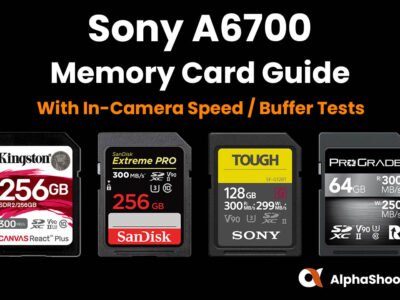

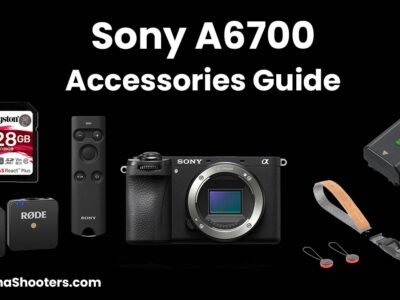
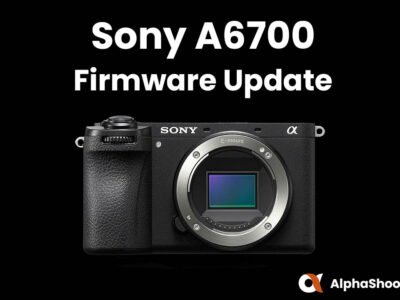
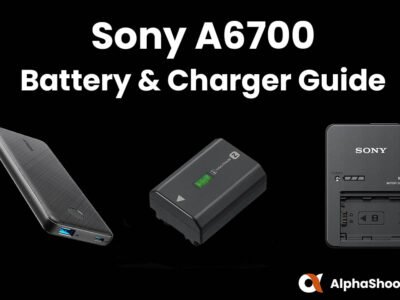



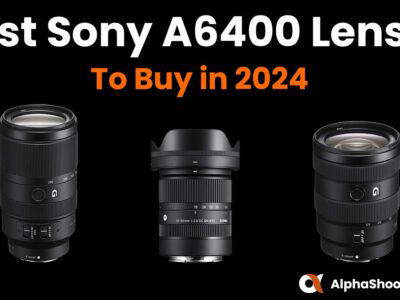
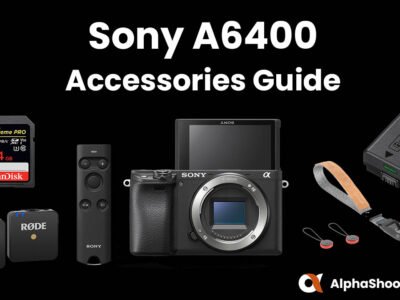


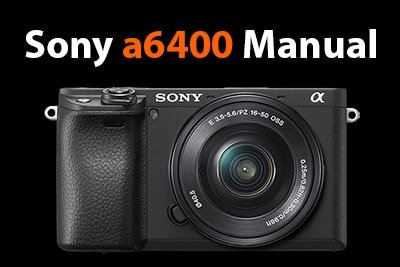
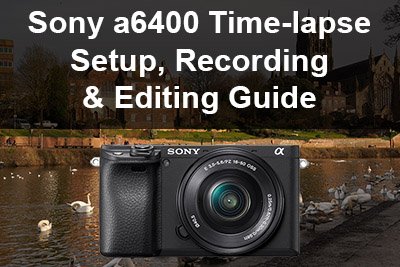

I am making this call now but I am not sure I agree with the emotive “But if you have a tight budget…” conclusion about going with the 6400 after reading through the comparison. That makes it sounds like only desperate cheapskates would go for the 6400. The thing is that there are always people who have the latest and the best but with the new release the older models come down in price. So for me in NZ, I can pick up the A6400 for $1197 body only compared with the 6700 for $2677. That’s 2.3 times the cost and the $1480 can buy you some very nice lenses. So for me, I can afford to pay more but it’s a question if value and whether the differences are worth it. I don’t take video, I will by lens with stabilisation, I can focus on my subject without AI, I am not convinced the benefits are worth the price hike, personally. If I was pay that much more it would make sense to jump to full frame alpha 7 series, but I am looking at keeping it light for travel. Cheers for the useful review.
no video recording time limit on 6700?
There’s no recording limit on the a6700. You can keep shooting until your battery dies or your card fills up. Although it might overheat before then.